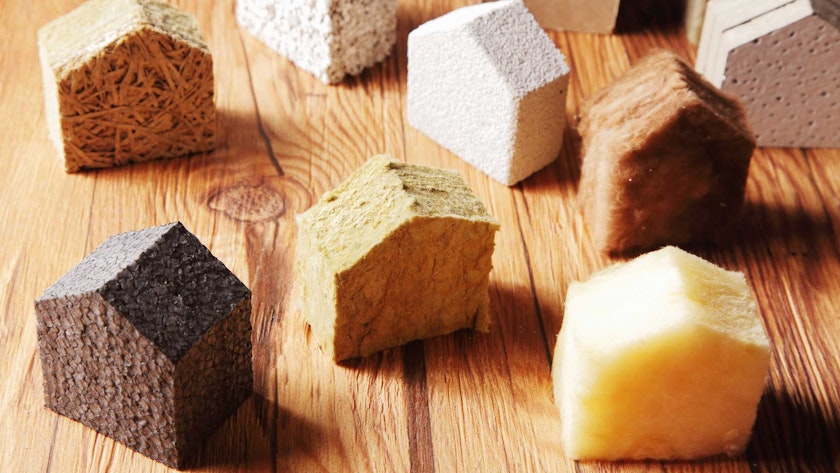
To reduce energy use and cut emissions, we need to insulate millions of UK homes, but choosing the right material isn’t always straightforward. We explore some of the options.
Most of the houses we live in now will still be in use for decades to come – and millions of UK homes need to be retrofitted to radically improve their energy efficiency as we transition to zero carbon. Effective insulation is a vital part of this, but the materials we choose can make a big difference.
Types of insulation materials
There are basically three different types of insulation material:
- Organic – those derived from natural vegetation or similar renewable sources, which tend to require a low energy use in manufacture (a low ‘embodied energy’). Examples are sheep’s wool, cellulose, cork, wood fibre, and hemp. Some are recycled from waste paper or textiles.
- Inorganic – derived from naturally occurring minerals which are nonrenewable but plentiful at source. Likely to have a higher embodied energy than organic materials. Examples are mineral/glass fibre, perlite and vermiculite (from volcanic rock) and rigid foamed glass. Some of these could be from recycled sources.
- Fossil organic – derived by chemical processes from fossilised vegetation (oil) – a finite resource. Fossil organic insulation materials such as expanded polystyrene and polyisocyanurate or phenolic foam are highly processed, resulting in a high embodied energy than either of the other types above.

Which is best?
If possible it is better to choose insulation materials that have not been heavily processed as this will reduce the carbon footprint and environmental impact of your home. The breathability of insulation materials is particularly important in older buildings (with solid walls). But as long as issues like breathability and damp risks are addressed, inorganic or fossil organic materials are better than nothing at all, because insulating your home will lead to energy and pollution savings. Many grant funded schemes may offer only a limited choice of materials, and there is not an organic insulation material suitable for cavity wall insulation.
The costs of insulation materials vary quite a bit, so do check what the current options are for your project. Some types of plastic foam can be quite expensive, and natural fibre insulations are getting cheaper as companies start manufacturing these on a larger scale within the UK.
If doing the work yourself, think also about the ease of installation when making a choice. Fluffy insulation is good for rolling out in lofts and suspended floors, for a tight fight between joists. Rigid boards are good for solid walls or across the underside of rafters in an attic room (to add to insulation between rafters). Each of these will come in certain sizes and will need to be cut to shape if you have some unusual spaces. Some materials can be cut with a knife, but a few will need a saw. You should still wear a face mask when cutting and laying any type of installation, because it’s best not to inhale small fibres of any kind.
With any insulation, the right method of installation is needed to avoid problems such as damp, thermal bypass, and thermal bridging (where a solid material spans across the insulation). Materials will often need to be installed with suitable vapour control layers above and/or below them. Suppliers of materials should have guidance documents on suitable layers for different jobs.
Solid walls could be insulated either externally or internally with rigid boards, fixed to the walls with screw fittings, and rendered or plastered. Solutions are available as a package that will include compatible render or plaster, to give a robust finish. If using a fluffy type of insulation, this will need to be held within a timber framework, and careful design is needed to minimise thermal bridging by the timber.
How thick?
The ‘thermal conductivity’ of insulation measures the amount of heat loss, so a lower value means less heat loss for the same thickness of material. It measures heat loss in watts, per metre thickness of material, per degree difference (in kelvin, K) – abbreviated to W/mK.
Most natural fibre insulations will have a thermal conductivity of between 0.035 and 0.040 W/mK, which is similar to polystyrene and glass fibre insulation. Some types of plastic foam have a lower thermal conductivity of about 0.02 to 0.025 W/mK, which means they can be half to two-thirds as thick for the same heat loss reduction. However, they can have issues with breathability in an old house, will have involved more pollution and energy use in manufacture, and will be harder to eventually dispose of.
There are other synthetic materials with even lower thermal conductivity, such as aerogel insulation (like ‘spacetherm’) at only about 0.015 W/mK thermal conductivity or sealed vacuum panels at 0.007 W/mK – but these have much higher costs and embodied energy.
Meeting the standard for solid walls
For a house with solid walls, adding just a few centimetres of insulation has a big effect. Where space is really limited, about 5 centimetres of something like wood fibre insulation board could cut heat loss through the walls by about 75%. Adding about 10cm could result in about 85% less heat being lost through the wall.
Products that are only a few millimetres thick won’t have anywhere near as much effect as adding a few centimetres of insulation, but can cost as much or more. If you have questions about solutions you’ve been quoted for, you can contact us. The U-value that needs to be met for building regulations can be adjusted depending on circumstances. This value measures heat loss in watts, per square metre (e.g. of wall), per degree difference – abbreviated to W/m2K.
There’s a target U-value of 0.3 W/m2K for solid walls, but you don’t necessarily need to meet that. You need to meet the lowest value that is “technically and functionally feasible” and will “achieve a simple payback of 15 years or less” – and that could be up to 0.7 W/m2K (the higher the U-value, the more heat loss). About 5cm of almost any insulation can get you below that 0.7 W/m2K U-value.
Other things will affect the overall heat loss from a house, including the roof and floor insulation, window size and quality, and air leakage through draughts. Some amount of solid wall insulation will be part of reaching a good overall standard.
For more specific guidance on insulating different parts of a house, see the information pages on CAT’s website or contact the information service.
Finding eco-builders and further advice
The AECB promotes sustainable building and retrofit, and you can find eco-builders using their directory of members (enter a location filter to show local contacts). Another listing site for green builders is the Green Register. For links to other places to find local builders, and for more about specialists in particular building materials and techniques, you can contact CAT’s Information Service.
Support our work
Did you know that CAT is an educational charity? If you have found our Free Information Service useful, please consider becoming a member or making a donation to support our work.
Related Pages
Related events


Build a Small Wind Turbine (Only three places left)
5th October 2024
Zero Carbon Britain: Carbon Literacy for Local Authorities Online
8th October 2024
Renewables for Households: Insulation
23rd November 2024EMAIL SIGN UP
Keep up to date with all the latest activities, events and online resources by signing up to our emails and following us on social media. And if you'd like to get involved and support our work, we'd love to welcome you as a CAT member.
